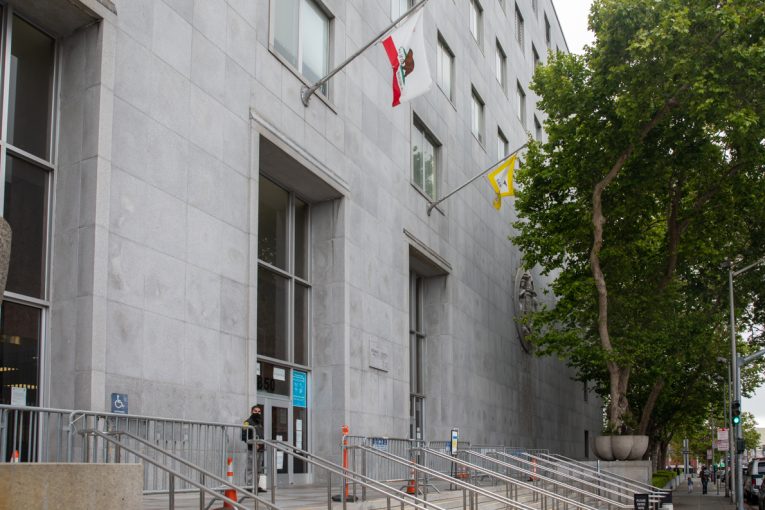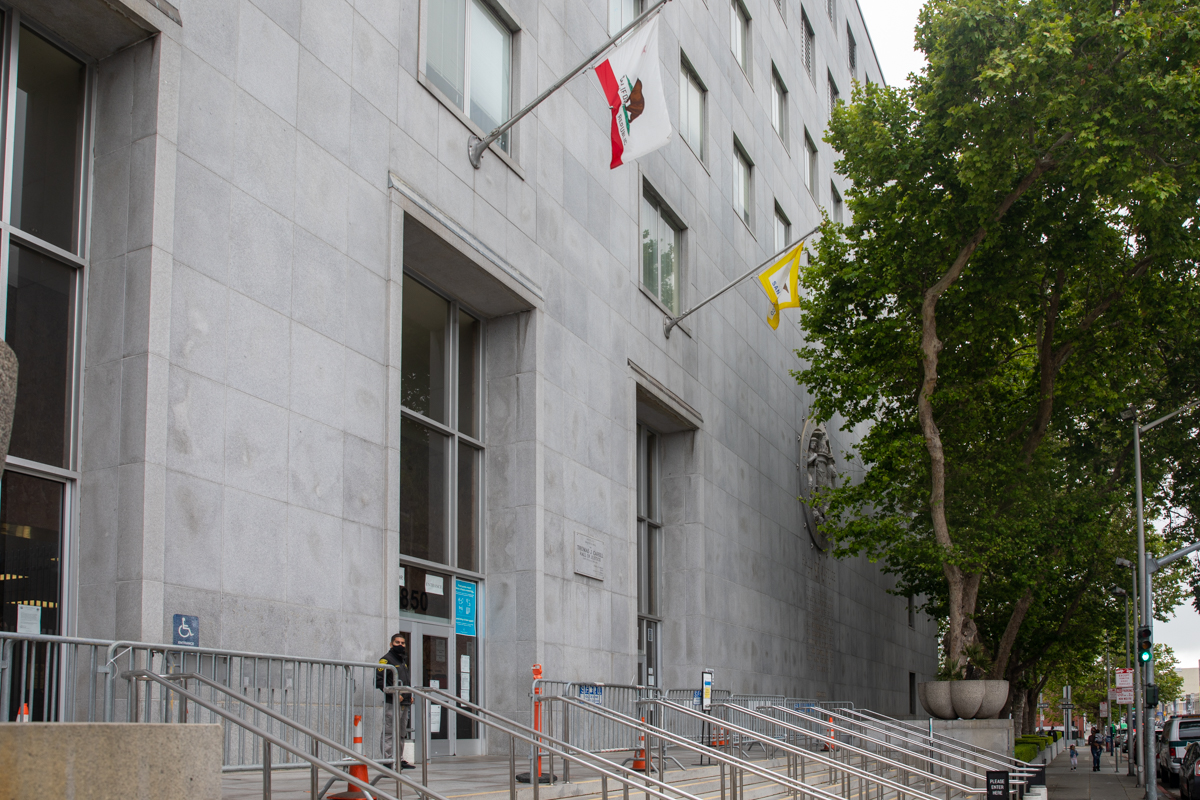

By Elena Rawlinson and Ella Wade
SAN FRANCISCO, CA– Most defendants don’t take the stand in serious felony trials – but Monday, Omar Herrera did just that in San Francisco County Superior Court, providing emotional testimony and context to his charges of first-degree murder on March 18, 2020.
The defense began by asking Herrera a series of questions about his childhood.
Herrera explained that he grew up in the Mission and the Tenderloin in San Francisco. He was taken away from his mother at the age of one, and was raised by his grandmother. During the time of the alleged murder, Herrera’s father was in prison, just one of several times Herrera’s father had been incarcerated during Herrera’s lifetime.
Herrera had been diagnosed with anxiety, ADHD, depression, and asthma. He was not on any medications for these conditions during March of 2020. 
The defense proceeded to ask Herrera about his economic situation and career aspirations during the period of March 2020. Herrera explained he was employed, received $1,000/month from the government for being in foster care, sold weed on the side, and was confident his family could help him secure a job if necessary.
With this context established, the defense questioned Herrera about the various instances his safety had been threatened throughout his childhood–experiences which would eventually push him to purchase a gun for his own protection in 2019.
The first incident Herrera detailed took place when he was 15. Herrera was walking in North Beach with his friend Nathan. A van pulled up next to them. The two boys walked away from the van but one man got out of the van and had his hand in his backpack. Herrera explained that at the time, he thought the man had a gun. Herrera and Nathan became scared so they grabbed some pebbles to throw at the man and ran away.
The second key incident of violence in which Herrera feared for his safety took place a few months after the incident at North Beach. Herrera was again with his friend Nathan. They were on their way to a friend’s house, and they got off the bus at 3rd and Mission. They noticed three men drinking on the corner.
As the two boys made their way to their friends house, Nathan accidentally bumped into one of the men. Nathan first attempted to explain that he had bumped into them by accident, but when that didn’t appease the man he walked away.
One of the drunk men walked towards Nathan and Herrera, and when he was about 20 feet away from the two he pulled out his gun and shot twice. Herrera explained that he froze and became numb, the world went silent. The defense asked, “were you really scared?” Herrera quietly responded, “yeah.”
The third life threatening experience Herrera relayed to the judge and jury took place in Dolores Park. He was in the park with Greg–Nathan’s brother. The two were smoking weed. The two were positioned at the statue and took note of a fight taking place by the benches. The fight eventually ended and everyone involved left the park. A little while later, one man returned to the park. He mistook Greg and Herrera as his opponents from the fight.
The man pulled out a BB gun and shot Herrera three times in the stomach. The defense presented the court with an image of the gun used against Herrera that day–pointing out that it was all black and shaped like a real gun. Herrera articulated that he believed he had been shot with a real bullet in the stomach that day in Dolores Park.
The fourth time Herrera described during his testimony on June 28th, 2021 took place when he was 17. Herrera was in SF with a friend, Trevor. The two were headed to Trevor’s house. They took Bart to the bus station. Trevor then noticed that there was a car near them and the people in the car were looking at them. Herrera didn’t recognize anyone in the car.
The car followed them as they walked, Trevor began to run away from the car. Herrera tried to run but became tired and tripped. As soon as he fell to the ground, the men exited the car and proceeded to kick and punch Herrera. Herrera explained that he was scared and it hurt, and he was “waiting for it to stop.”
When the assault finally ended, Herrera got up and called his father. The defense asked Herrera why he didn’t call the police, and he explained that in his experience calling the police doesn’t help.
The fifth incident Herrera detailed took place near city college. Herrera signed up for an algebra one course–he hoped to take this course as a means to pass the exam for the SF electrician attorney position which he had previously failed. After signing up for this class, he walked to the bus stop. Herrera then decided the bus was taking too long so he began walking home.
Herrera saw a man with a gun in a car drive by. Herrera recognized this man from the Mission, and he was fearful so he made his way to Riordan high school where he hoped he would be safe. He saw the man with the gun drive by Riordan, following Herrera. The man pointed the gun at Herrera through the car and Herrera “got scared.”
The final incident that pushed Herrera to purchase a gun for his own safety took place at the end of 2019. Herrera was walking home from his aunt’s house in the Tenderloin. He was on his phone while he walked, and he accidentally walked into a drunk man. The man thought that Herrera had walked into him on purpose.
Herrera tried to explain that it was an accident, but the man didn’t accept this answer. Herrera tried to walk away but the man grabbed him by the front of his hoodie. Herrera punched the man one in order to get him to let go.
The girlfriend of the drunk man threw a glass bottle at Herrera’s face. He was left with several facial cuts and ended up going to the hospital to get stitches.
A week after the final incident, Herrera decided to purchase a gun. Herrera confirmed that he didn’t purchase the gun to hurt people or commit crimes, but rather to protect himself. Herrera testified he purchased the gun “so I don’t have to worry about anything worse happening.”
Herrera confirmed that when he bought the gun it was loaded. He never added bullets to it. He carried the gun with him at all times, except at his family’s houses. Herrera stated that he felt safe there.
Following these stories of abuse and assault, the defense began asking Herrera about the events leading up to the day of the alleged murder and the events on March 18, 2020.
Herrera’s job at the Chase Center had just been put on hold for three days due to COVID-19. Despite the potential lay off, Herrera wasn’t worried about work or money because of family members who could get him work if things stayed that way for a while.
Herrera was living at his paternal grandmother’s house, he has his own room and pays rent. Herrera had been scrolling through Instagram when he saw that Isaiah went live. Herrera started talking to Isaiah, the later then asked if Herrera could sell him weed. Isaiah asked if Herrera wanted to smoke with them, he said yes and Isaiah came to pick him up at around 4 p.m.
Isaiah picked him up, in a friend’s car. A friend, Mr. C, who owns the car, was driving. Herrera asked to stop at a corner store to get some water before they went to smoke. They stopped at a store on 24th and Potrero. Herrera and Isaiah got out, Herrera got a bottle of water and as they were leaving the store Isaiah stole an iPhone from an older woman who was standing near them.
The car had been circling the block but was double-parked in a bus lane when Herrera and Isaiah began running away from the woman. Herrera was unaware that Isaiah had stolen the phone until they were almost in the car. While they were running Herrera, who testified as not being bossy or one to tell others what to do, repeatedly told Isaiah, “Don’t ever do that again” multiple times.
They drove around a little more and at one point Isaiah asked Mr. C to stop the car so that he could go sell the phone because his birthday was coming up and he wanted some money. When Isaiah returned to the car he had sold the phone and was waving and playing with $300 that he had gotten in exchange for the phone.
They then drove to the Bayview where Herrera sold weed to the people in the car. They stayed there and smoked for a couple hours. Mr. C had brought some pills, thought to be Percocet and Xanax, but he was the only person who took them.
Herrera asked to go get food at McDonald’s, as they were driving Herrera was very tired and began nodding off. He hadn’t eaten any solid food all day and had been smoking weed for a while at that point. Because of this he doesn’t remember if there were any stops made aside from the two that he remembers.
Herrera recalls Isaiah stopping at a stop sign near 21st and Shotwell where Isaiah turned to Herrera and said, “There’s some hoes over there” referencing the sex workers that were standing on the corner. They kept driving until Isaiah stopped at the park by 21st and Shotwell Street, where Isaiah told Herrera to “Hold on.”
Isaiah got out of the car and walked to the corner. Herrera felt unsafe in the car and walked out to go and ask Isaiah what was going on. When he got near Isaiah, Isaiah began walking in the street near the driver side windows of the parked cars.
Herrera saw a man on the other side of the street with his door open and thought that Isaiah was going to go talk with that man, but Isaiah walked back to the sidewalk towards a man standing with a woman who was later identified as a sex worker.
That’s as far as Herrera got Monday. The trial reconvenes Tuesday.
To sign up for our new newsletter – Everyday Injustice – https://tinyurl.com/yyultcf9
Support our work – to become a sustaining at $5 – $10- $25 per month hit the link:
